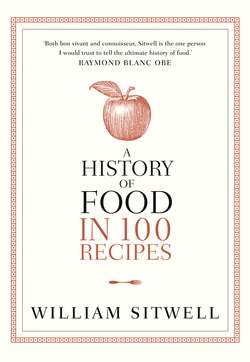Читать книгу A History of Food in 100 Recipes - William Sitwell - Страница 13
Оглавление6
Roast goat
30 BC
AUTHOR: Virgil, FROM: Georgics II: 545
Therefore to Bacchus duly will we sing,
Meet honour with ancestral hymns, and cakes
And dishes bear him; and the doomed goat
Led by the horn shall at the altar stand,
Whose entrails rich on hazel-spits we’ll roast.
You may not consider Virgil to be a recipe writer, yet here is what amounts to a recipe for goat, roasted on an early version of a spit. And I’m not the only one who has cited this extract as a recipe. It was quoted back in the 1800s, to illustrate the simplicity of roasting as a cooking method. In a section entitled ‘The Ladies Department’ in an 1825 edition of the US publication the American Farmer, the poem is referred to with the comment that ‘Roasting is the most simple and direct application of heat in the preparation of food.’ While four years earlier, in 1821, Frederick Accum in his Culinary Chemistry also cites Virgil, going on to say: ‘Roasting on a spit appears to be the most ancient process of rendering animal food eatable by means of the action of heat.’
Before metal spits were devised, meat would be skewered onto branches pulled from trees – often hazel wood, as in Virgil’s poem. The sap in the wood, when heated, would make the branch turn (so long as the animal being cooked was light enough, such as a small bird like a lark; it wouldn’t happen if you skewered a pig on it) and people who witnessed it thought it supernatural. Hazel was also used as a divining rod.
But quite how roasting came about can only be guessed at. For thousands of years the human race ate its food raw, and then between the discovery of how to make fire and the appearance of the Neanderthals, man began to cook his food. So at some point, while using fire for warmth or to ward off wild animals, a discovery was made. Did the spark from a fire catch light and burn down the lair of some wild pigs? Did man smell the roasting fat and try out the first pork scratchings? Or did a grazing mammoth fall into a fire pit, the smell of its cooked flesh wafting on the wind in an appetising new aroma?
However it happened, man’s use of fire to cook was revolutionary. It wasn’t just the new flavour that it introduced to food, but the inedible then became edible. Items that could only be eaten when cooked – wheat, barley, rice, potatoes – were then worth cultivating. As man consumed more nutrients, his health must have benefited too. Furthermore, his use of fire for cooking is one of the decisive factors that separates him from other animals. When man cooks, he becomes fully human. Animals may store food – dogs bury bones, racoons douse their food in water – but only humans cook it.
Having learnt to roast food, man then got all sophisticated and started boiling it. So where roasting – or burning – food distinguished us from animals, boiling was proof of civilisation. The anthropologist Claude Lévi-Strauss muses on this point. In his essay ‘The Culinary Triangle’, he thrashes out his theory on cooked food. ‘The roasted is on the side of nature, the boiled on the side of culture,’ he writes. This is literally true because boiling requires the use of a receptacle, a cultural object: ‘Boiling requires a mediation (by water) of the relation between food and fire which is absent in roasting.’
Thus, as we became cultured so roasting was seen as primitive and basic, while boiling was regarded as sophisticated and classy. Until more recently, that is, as we became increasingly sophisticated and decided that roasting was in fact rather more upwardly mobile. After all, the urbane gentleman doesn’t take pride in his ability to do a nice ‘Sunday boil’.
But he probably wouldn’t roast a goat either. Back in 30 bc, however, Publius Vergilius Maro – Virgil, to his friends – was more than happy to, and his reference to goat, spit-roast on hazel wood, comes in his epic work The Georgics. The Roman poet’s most famous work after The Aeneid, this chiefly detailed methods of running a farm – instruction manuals for those entering the agricultural sector making for perkier reading when in verse. In it he writes of raising crops and planting trees, of keeping livestock and horses and beekeeping.
His reference to roasting goat comes after a section on pruning trees and then a note celebrating vineyards, whose vines teem with ‘mellowing fruit’. With his mention of Bacchus, the goat roasting feels like a celebration of successful farming. The ensuing lines instruct on how to look after the soil with a few notes on hoeing.
As Virgil gracefully instructs one on correct farming practice, so he whets our appetites for a good roast, the flavours of which echo down the centuries as resonant as his poetry.
